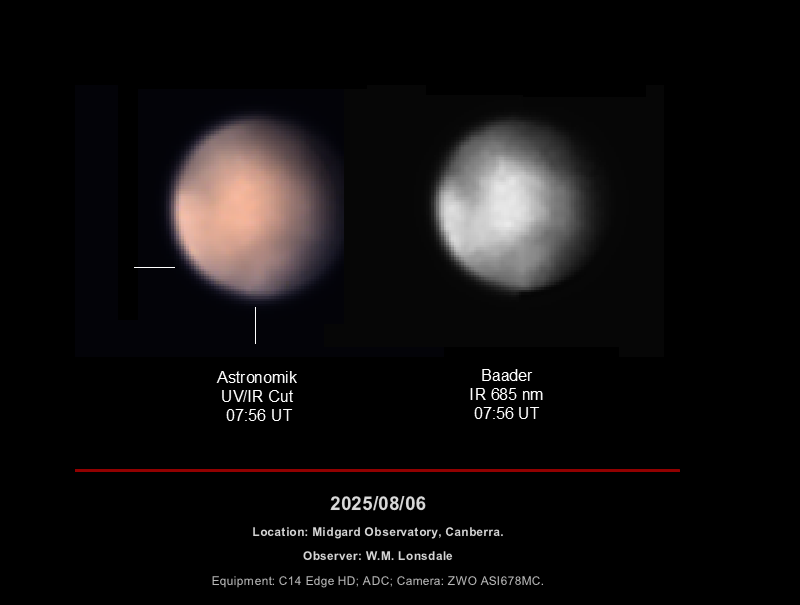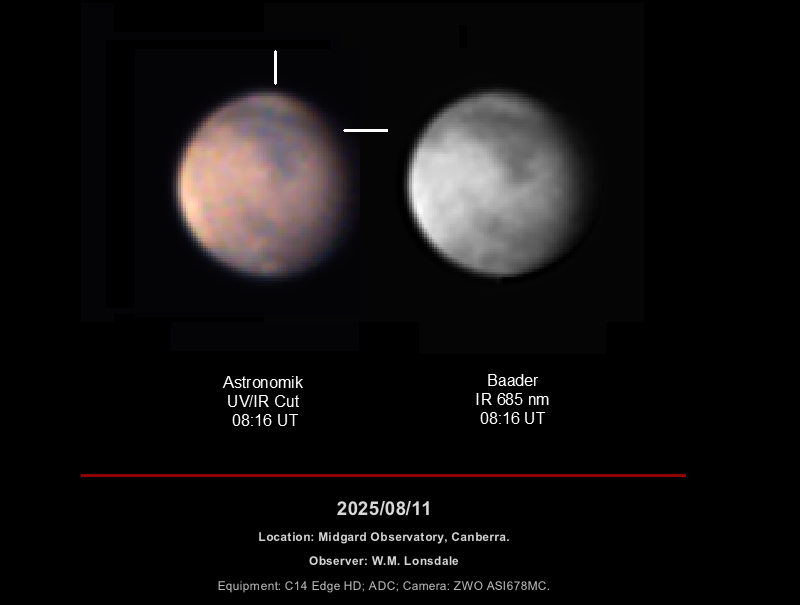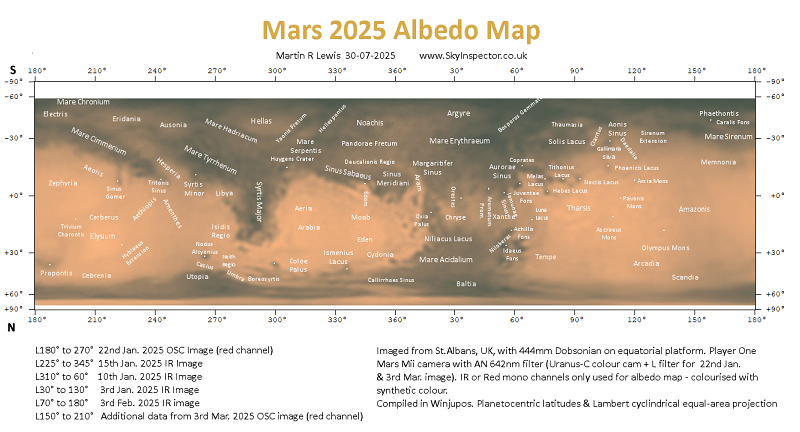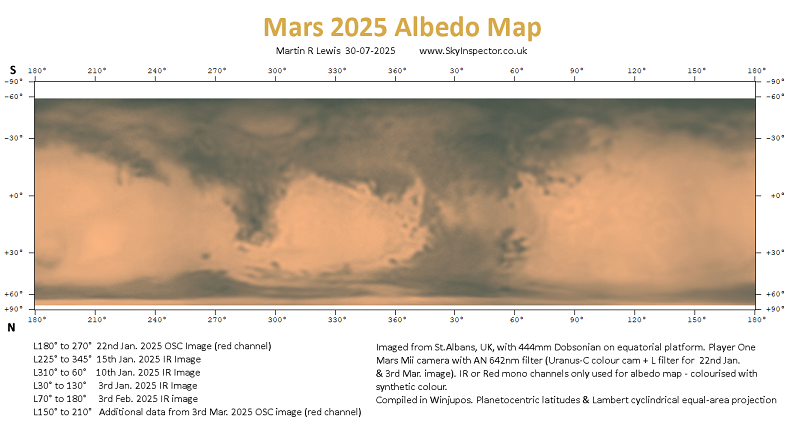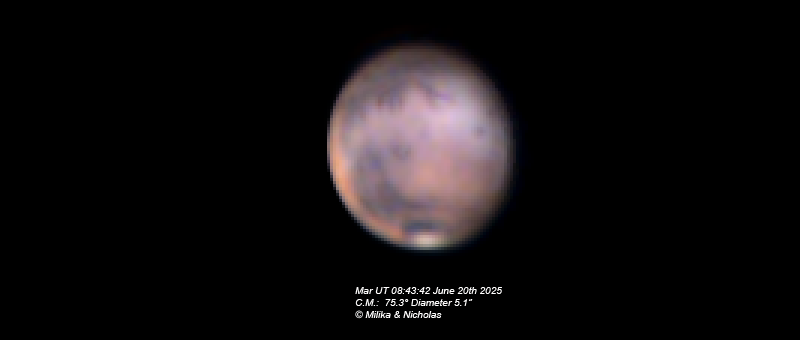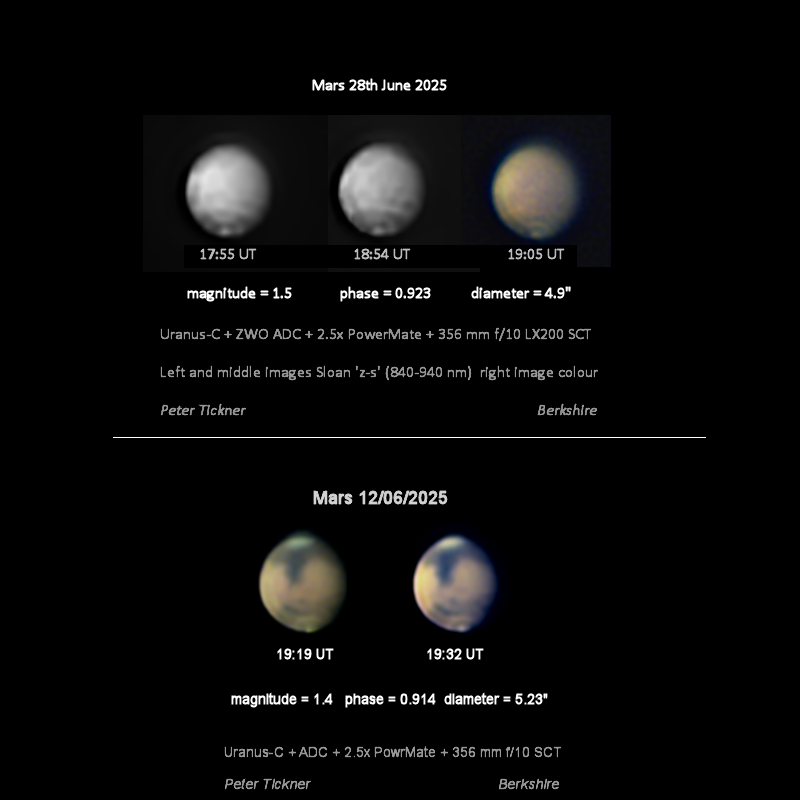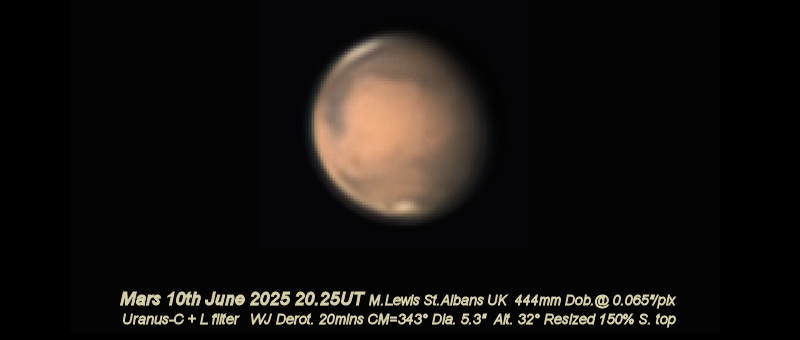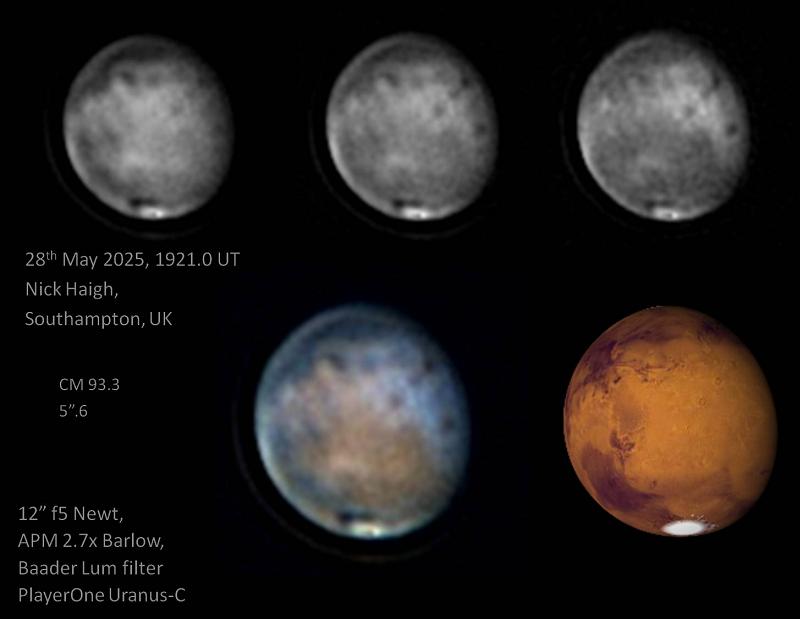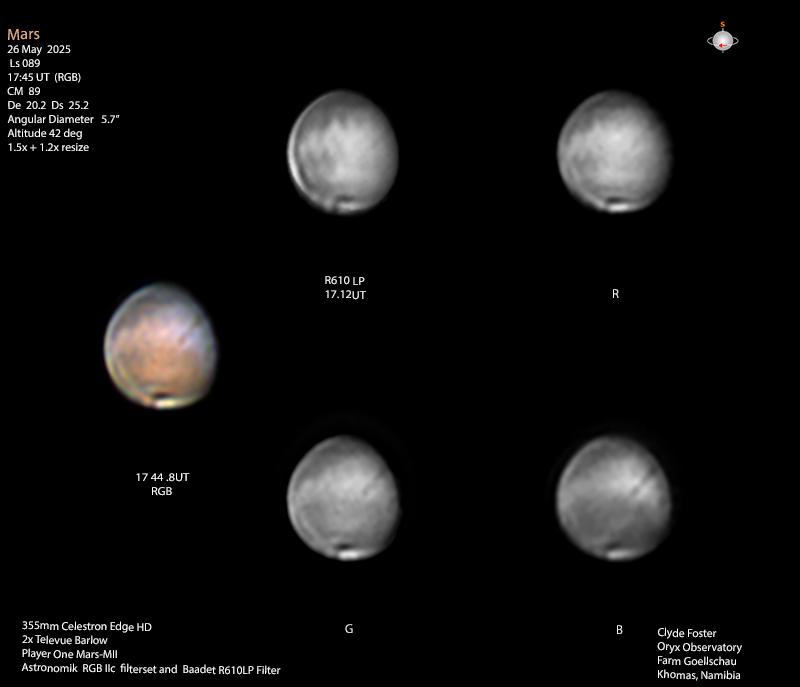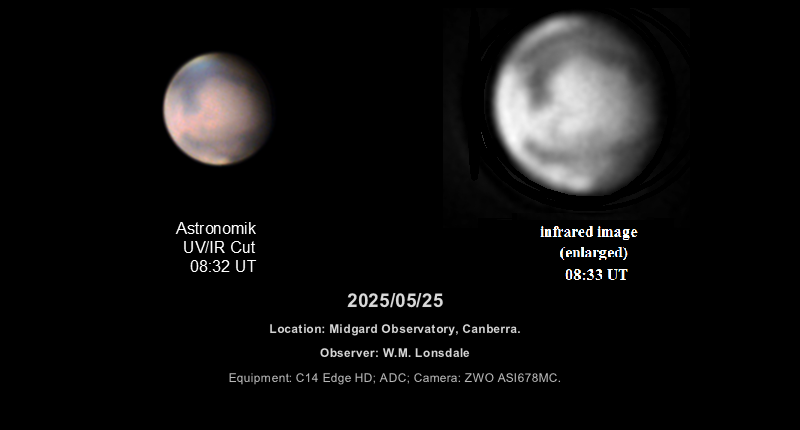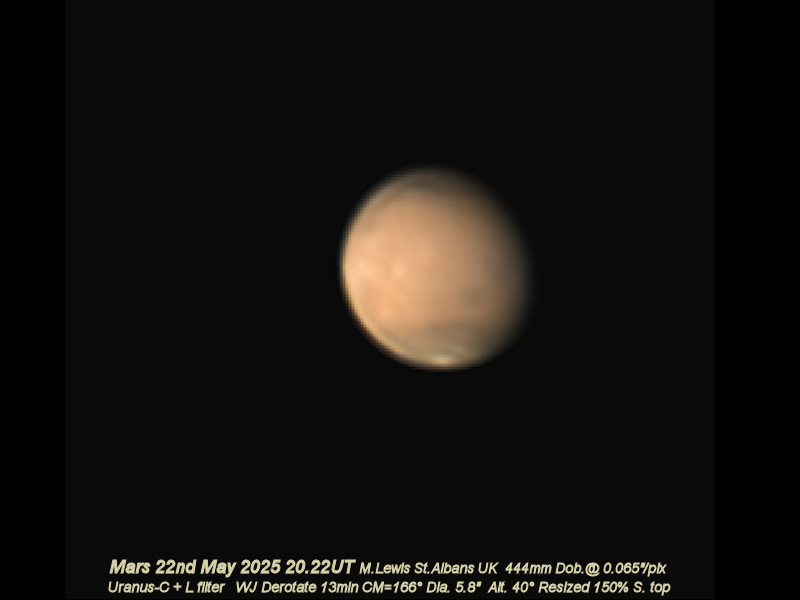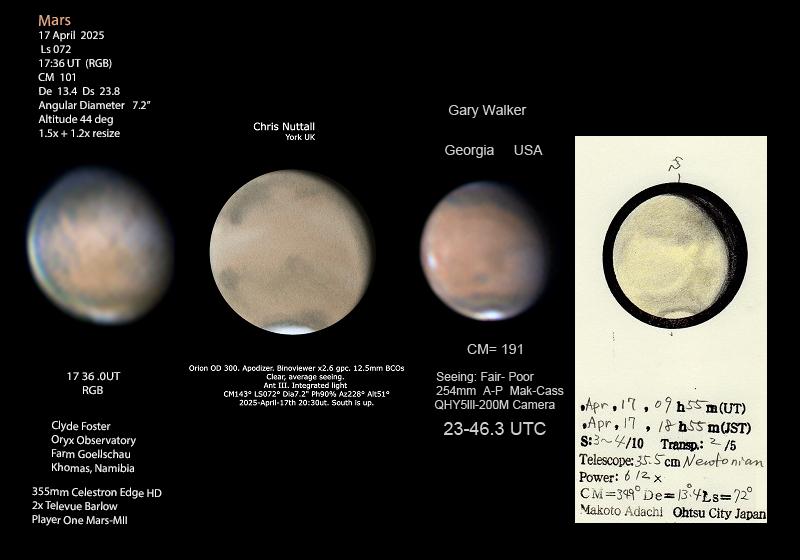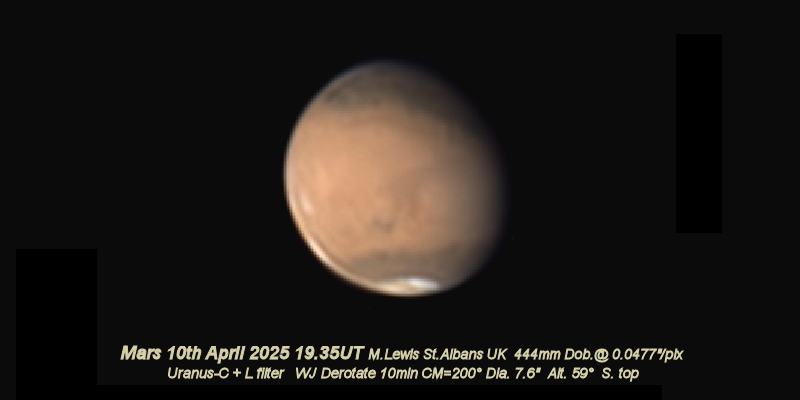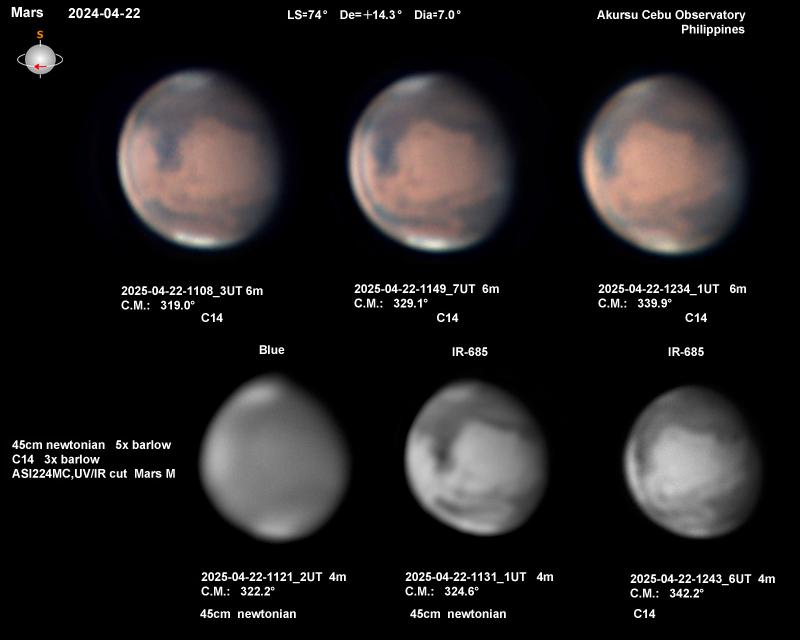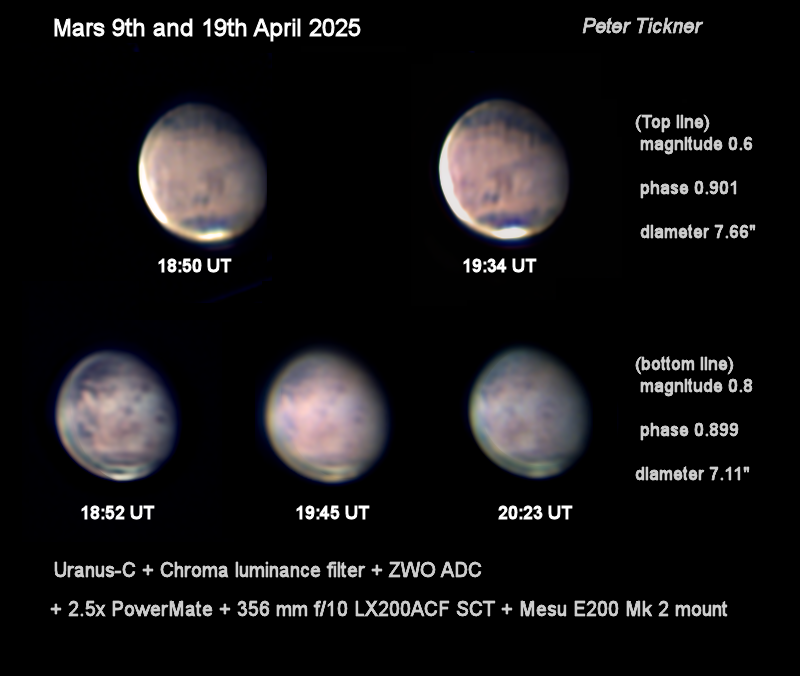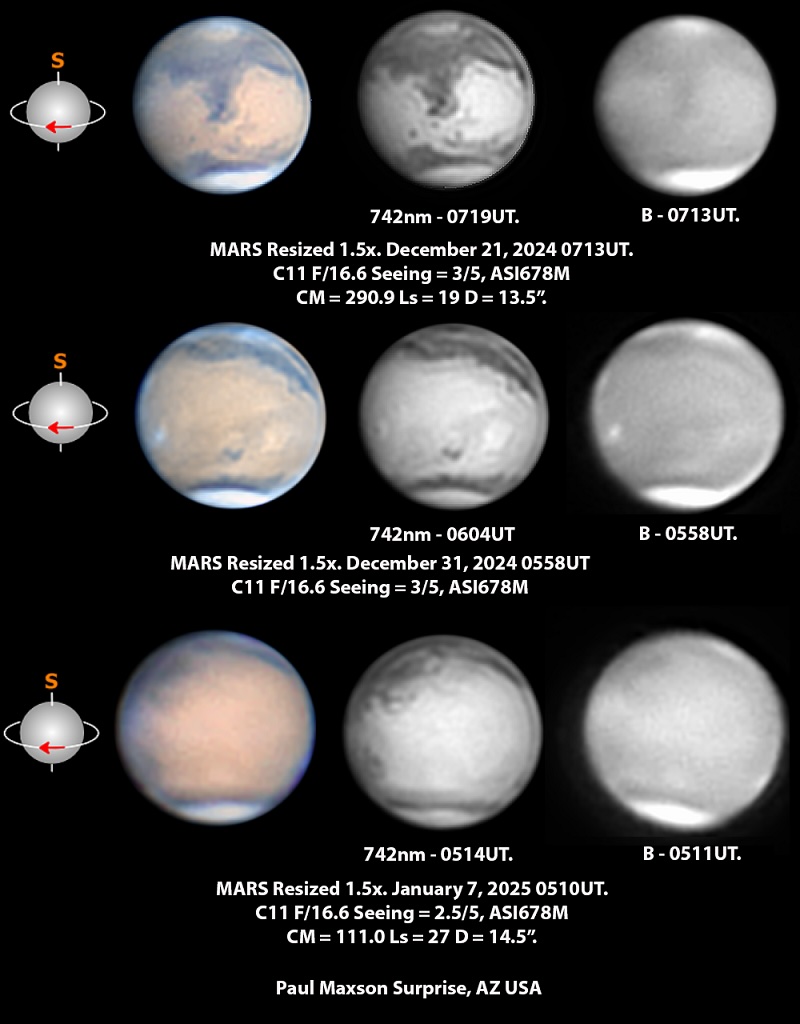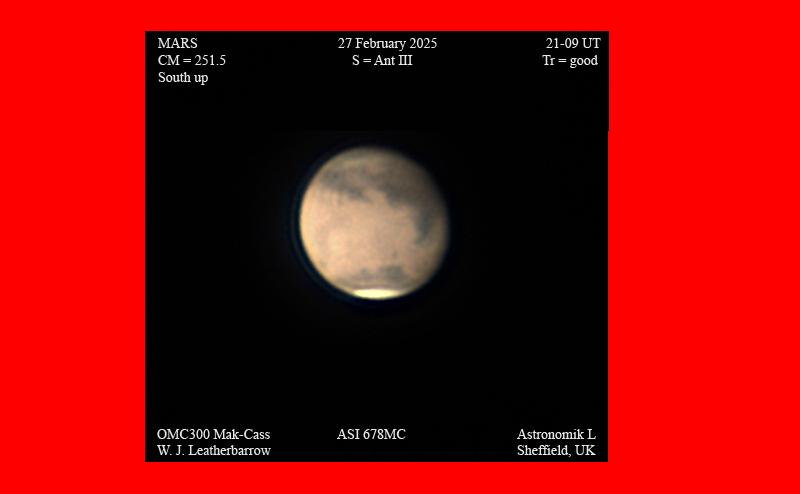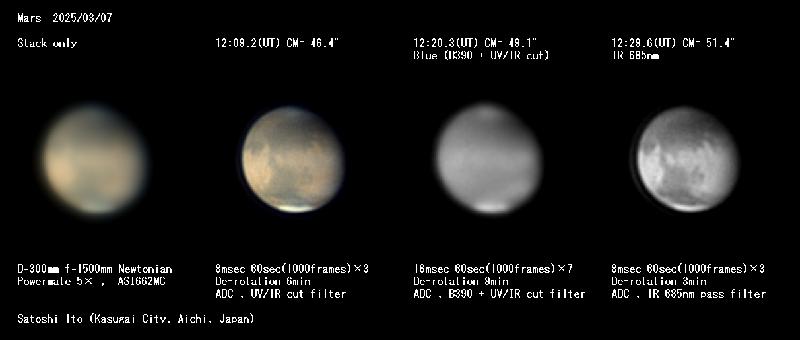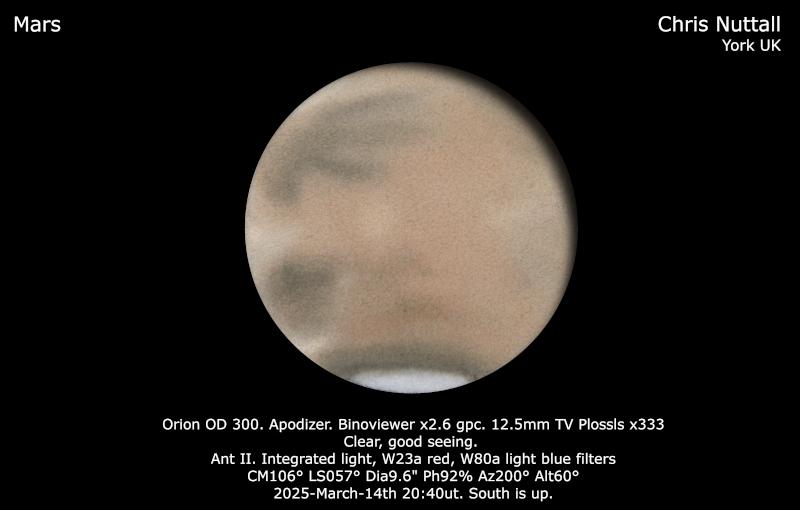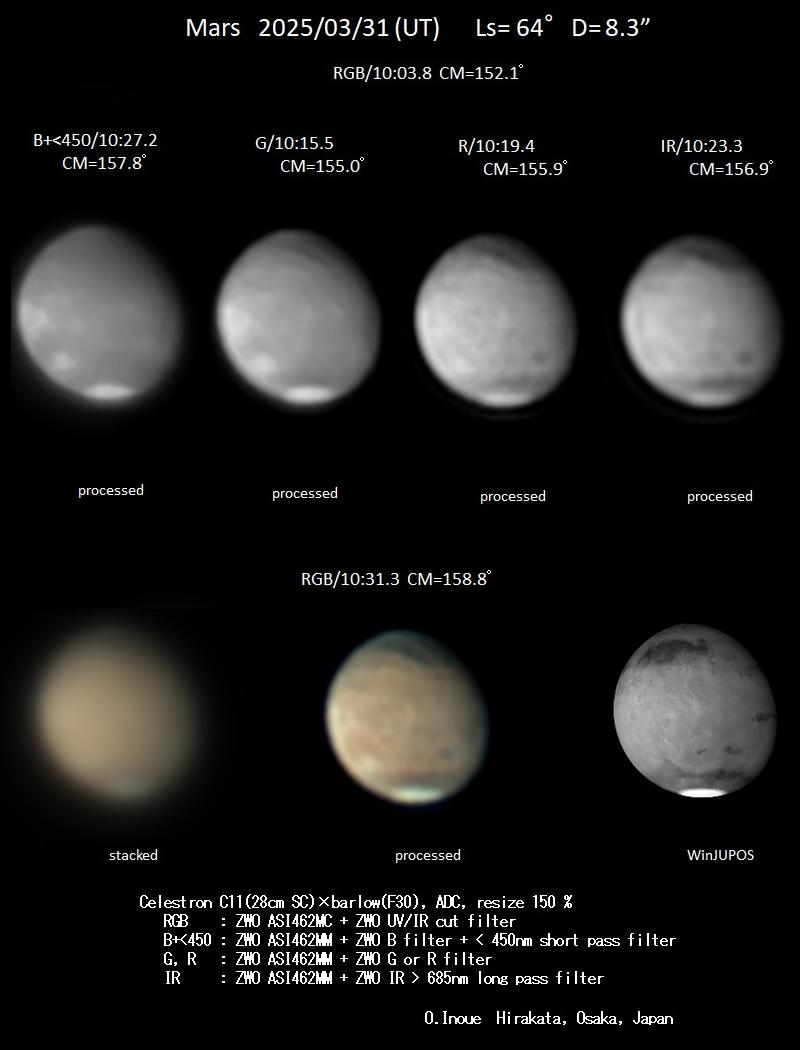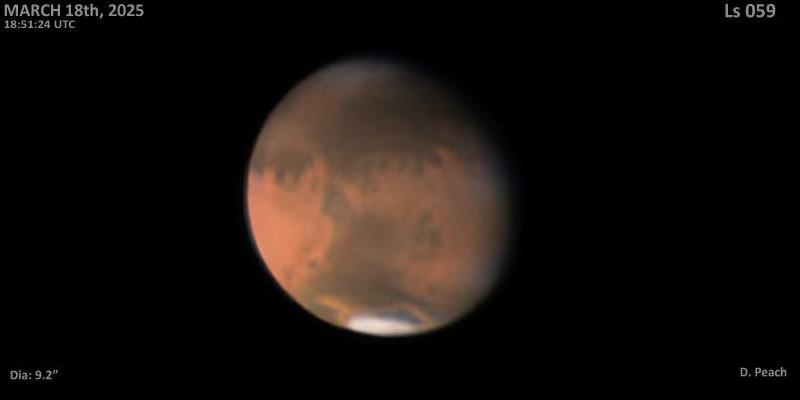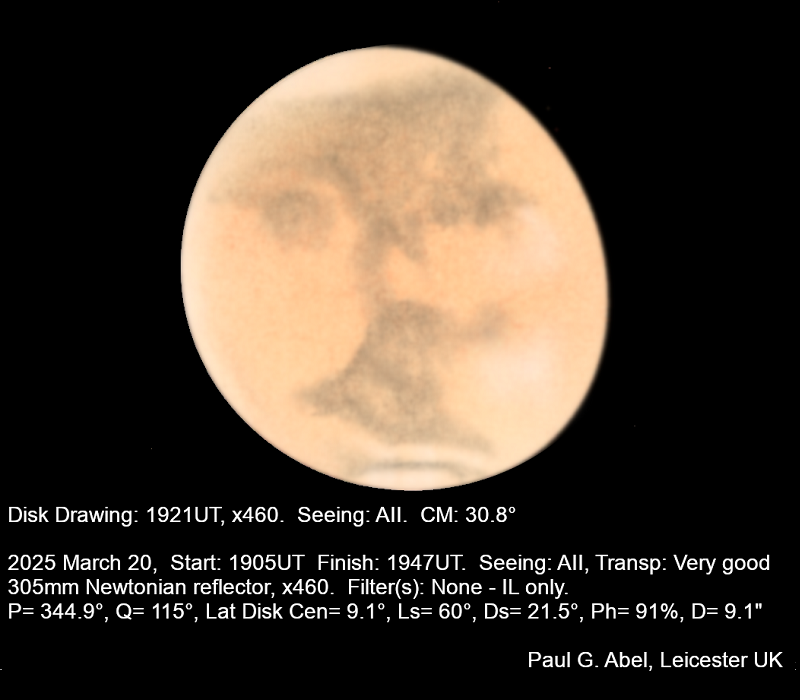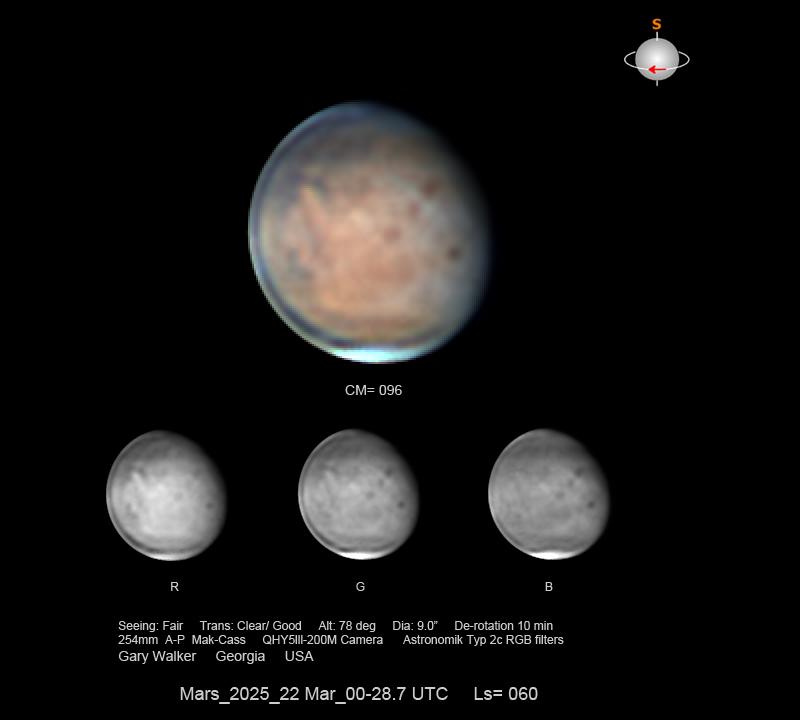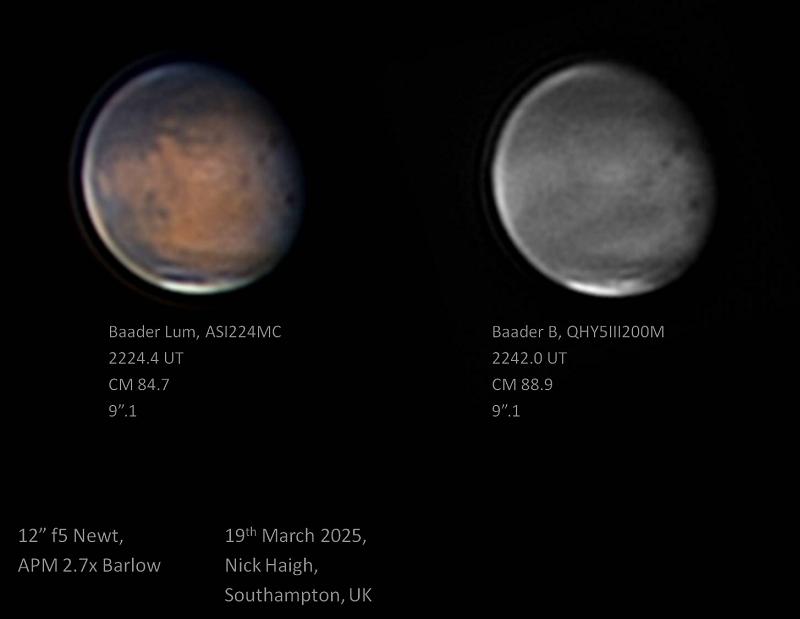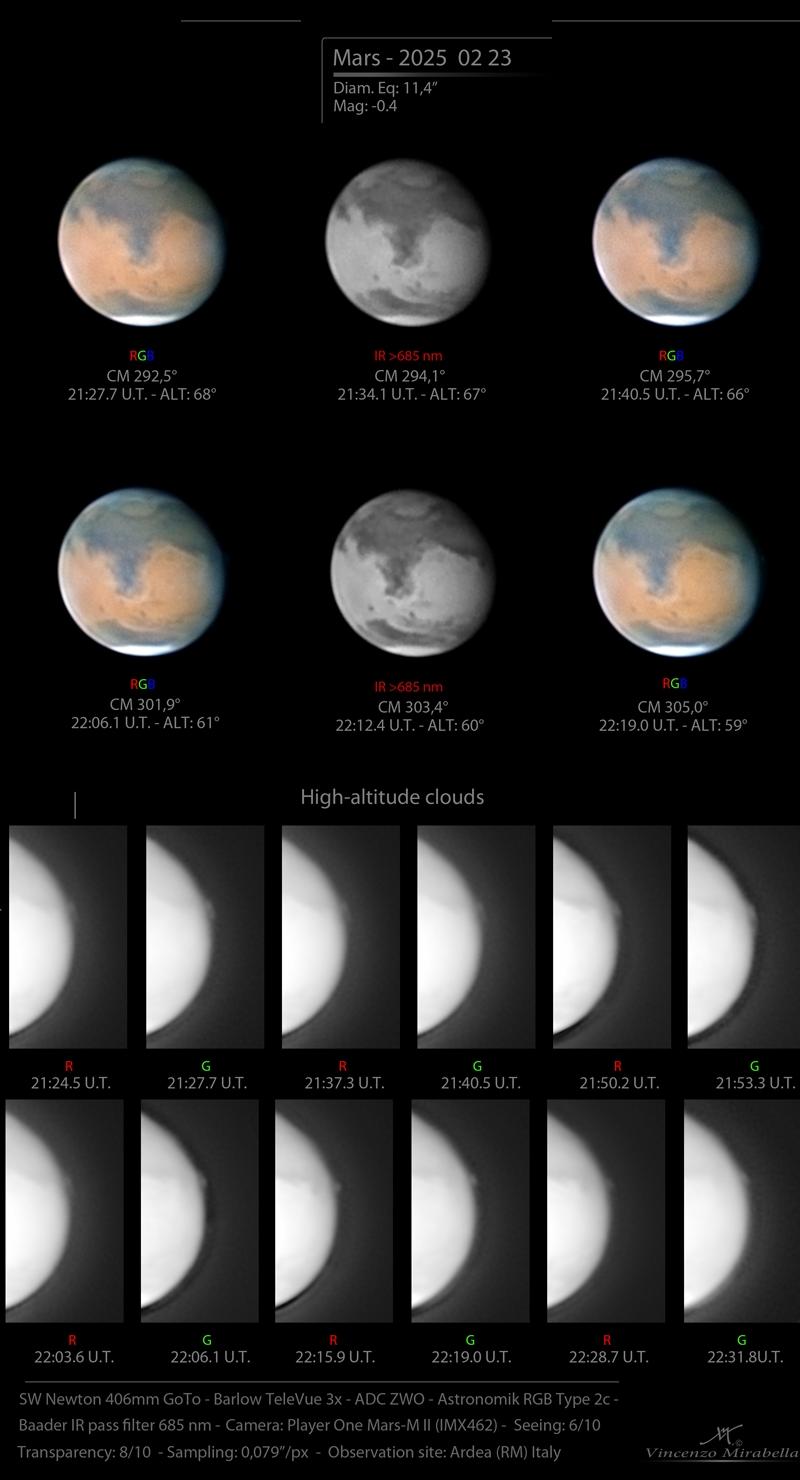Mars Opposition 2024-25
A blog of all posts for the 2024 – 2025 Opposition
Mars Opposition Blog 1 September 2025
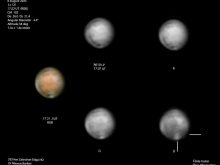
2025 September 1
The closing chapter in the 2024-25 apparition has been the anticipated appearance of the northern cyclonic clouds at two longitudes: Mare Boreum and Utopia. The clouds were recorded by Foster and Lonsdale. In this image of August 6 (CM = 102, Ls = 121) by Foster, we first clearly see a bright morning cloud at the edge of the polar cap. The cloud is strongest in blue light and looks circular. Lack of resolution precludes having any idea of its internal structure, but its first appearance at the correct place and at the correct seasonal date guarantees its nature. There is also an interesting image by Ito on July 26 at nearly the same CM longitude (CM = 108) which hints at the same phenomenon in an enhanced colour image; however, the cloud is not so prominent, and there is no blue image available. Another such cloud seems to be visible at the morning terminator upon Foster’s August 12 image.
In this image by Lonsdale for August 6, we appear to see a N-S elongated cloud streak at Utopia, this time in the early afternoon, and it is likely (but not certain at this level of resolution) that this was another cyclonic cloud. Another Lonsdale image for August 3, not posted here, might also show another, smaller and brighter cloud.
The recent images from the above observers this month, taken together with others by Akustu, Hillebrecht, Ito and Melillo demonstrate the continuation of the seasonal equatorial cloud band (ECB) and the frost covering at Hellas. (But the observations will surely not continue long enough to time the cessation of these phenomena.)
In this image by Lonsdale on August 11, a thin strip of ECB crosses the southern Syrtis Major. From memory I can confirm that seasonally similar records were obtained by BAA members in 1901, 1903 (Denning) and 1967 (Botham), and doubtless in other years too. The cases cited were more striking as in these earlier instances the observations were made much closer to opposition.
Finally, Martin Lewis has finished his impressive personal 2024-25 apparition maps, and I post them here (and will later put them up on the front page). One version is lettered, and the other is not.
At the time of writing (August 25), the last image of the 2024-25 apparition had been taken on Aug 22 by Melillo, and the final drawing by Adachi on July 19. As the observing season is either over or very nearly so, this will almost certainly be my final BAA Mars blog post for 2024-25. In due course I will write up the observations for the 2022 and 2024 oppositions for the Journal. For now I repeat my sincere thanks to all who made contributions.
Mars Opposition Blog 1 July 2025
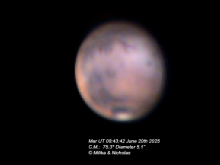
2025 July 1st
To view Mars now from the UK at a reasonable altitude now, it must be located before sunset. Fortunately some of our members are expert at doing just that, and it is a pleasure to show images by Martin Lewis and Peter Tickner. The planet is still being actively followed by the Australasian observers (see the images from Akutsu, Lonsdale, Milika & Nicholas and Ito, and the drawings by Adachi), from Continental Europe, from Namibia (Clyde Foster) and from the USA. The southern hemisphere observers are now favoured by the planet’s changing declination. I particularly wish to draw attention to the image of Milika & Nicholas for their resolution of the Tharsis Montes.
The continued brightness of Hellas implies ground frost. The orographic clouds are still visible, and the equatorial cloud belt remains prominent (as expected at this Ls). The tiny diameter of the disk (now dipping below 5 arcseconds) is now a severe resolution test, but the high quality of the images here demonstrates that it is still very much worthwhile to attempt to observe. No obvious dust storm activity has been noticed lately. The planet is now too distant to reveal any of the seasonal rifts in the summer cap, but the detached Olympia still shows up in the latest images, while the very best ones hint at the presence of another outlier.
I am including an image from earlier in the year (January 3) from Gary Eason (Colchester). Contrast the size of the NPC with now!
It is now time for apparition maps. From Prague, capital of the Czech Republic, Vojtěch Jančura made a map from his own images, posted on the Cloudy Nights forum. And now Makoto Adachi, Mars Coordinator for ALPO Japan, has made this fine hand-drawn chart from the images available upon the ALPO Japan and BAA websites. Compare this with the 2022 map by Lewis upon our front page.
All future contributions will be acknowledged. We now have received data from a total of 108 observers, and the Word document attached to the front page has been updated. I am particularly grateful to Massimo Bianchi, Mars Coordinator of the Unione Astrofili Italiani, who invited me to copy the images from the observers in their online archive, an offer which had also been made at past oppositions by his predecessor, Paolo Tanga. Several UAI members have already contributed directly to the BAA.
If I continue to receive observations, I will continue to update this blog.
Mars Opposition Blog 1 June 2025
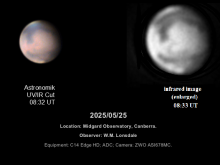
1st June 2025
The planet is now remote, well under 6 arcseconds in diameter, and observable only in the evening twilight. However, daily coverage continues by those sufficiently equipped to do so (and not having awkwardly-placed trees or buildings).
No changes in albedo features have been seen. The planet continues to show the usual seasonal behaviour. Dust activity has not been detected since the last blog entry.
The north polar cap is now very small. A very recent image by Nick Haigh (May 28) shows a seasonal rift in the N. polar cap (with a possible brighter patch on the following side). It also shows the continuing equatorial cloud belt, and the summits of Olympus Mons and the Tharsis Montes poking through the extensive white morning cloud. Another view by Clyde Foster (May 26) shows similar effects. The exceptionally dark patch near the cap in these images is Hyperboreus Lacus, a feature of this time of the martian year.
The equatorial cloud belt continues to cause a bluish or greenish tint to the Syrtis Major, especially when near the edge of the disk, and this effect was again reported by Frank Melillo on May 18 and 20. In blue light the Syrtis is invisible even at the CM. David Basey had a similar view on May 15, while Paul Abel observing visually on May 12 caught the bluish tint over the morning Syrtis.
The frost at Hellas mentioned in the last blog entry continues to be visible, and it was confirmed visually by Abel, Stanislas Macsymowicz, Andy Wilson and the Director. Here is an image by Mark Lonsdale (May 25) that shows it, and also confirms that the Olympia region had become seasonally detached from the N. polar cap.
Evening cloud over Olympus Mons and Tharsis Montes continued to be visible. For example, Peter Tickner caught the Olympus Mons cloud near the evening limb on May 19. On the 16th he imaged some light afternoon cloud over Elysium too. And here is an image by Martin Lewis (May 22) which in addition to showing orographic clouds, portrays the small dark dot of Propontis clearly on the NE side of Elysium, following the CM. His image also shows the detached Olympia.
I have received further images of the terminator projection mentioned in an earlier blog post, from Nick Haigh, who caught it on February 27/28.
All observations are welcome, and will continue to be acknowledged. If enough data are received, this blog will continue. We may not be able to record as much detail now, but we wish to monitor as much of the current martian year as we possibly can in order to time the various expected phenomena. By the start of August, the planet’s declination will soon favour the southern hemisphere, but I hope that UK observers can continue for at least a little into June.
Mars Opposition Blog 1 May 2025
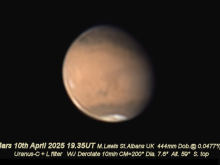
1st May 2025
A short update this time. The tiny martian disk has now slipped below 7 arcseconds in diameter, and several observers consequently have now stopped their work for the season. However, daily coverage of most longitudes continues, and to illustrate this here are some images and drawings from the same date, April 17, from C.Foster (Namibia), C.Nuttall (UK), G.Walker (USA) and M.Adachi (Japan).
The band of orange-coloured atmospheric dust over the cap, mentioned in the last post, continued to be visible for some time. For example, images by M.R.Lewis (UK) on April 10 (posted here) and by G.Walker (USA) on April 17 show it clearly. The dust appeared close to the position where the polar area known as Olympia detaches from the rest of the cap.
The seasonal separation of Olympia from the N. polar cap has been observed. Images taken on April 19 (Ls = 73 degrees) onwards by T.Akutsu (Philippines) (and his image of April 22 is posted here) may have been the first to show it clearly on the evening side, and many subsequent images by others have confirmed it. It may have been caught on the morning side a little earlier, though the situation at that time was confused by the presence of the aforementioned streak of dust over the cap. With the current viewing geometry it is easier to spot on the evening side, where the gap between Olympia and the cap is widened by perspective. The seasonal date is typical. For example in 2010 separation was complete by Ls = 74 degrees.
The summits of the Tharsis Montes and Olympus Mons continued to show up through morning cloud. See the images by P.Tickner (UK) on April 19 for an example.
The equatorial cloud belt (or band) has continued to be strongly marked in the images, though not appearing equally intense all around the planet. It is also apparent visually. On April 24 Abel and the Director saw it under CM = 69 degrees. It was brighter in the morning and evening where it joined diurnal clouds, and around Ophir-Candor.
The seasonal brightening of Hellas, due to ground frost deposition, ought to be visible soon. The latest images from April 24 show it light in blue light, paler than the N. polar cap, but not yet bright in red. Akutsu’s April 22 series (see earlier) shows its current wavelength dependence.
I am hoping we shall be able to continue our daily patrol for as long as possible.
Mars Opposition Blog 10 April 2025
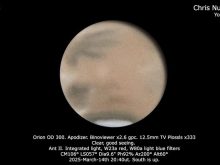
April 10th 2025
As Mars rapidly diminishes in size, I am starting with some earlier images by P.W.Maxson (USA) to remind us of the near-opposition period.
Moving ahead in time, an image on Feb 27 by W.J.Leatherbarrow (UK) shows the planet beautifully defined at the moment of our last update. But at the time of writing (April 7), the disk diameter has recently dipped below 8 arcseconds. To partially compensate, we have at least had an exceptionally long run of clear evenings in the UK, and sometimes even some decent seeing. As always, this update is not intended to be a complete analysis.
The south polar hood is now more prominent. Hellas is quite brightened by its presence but is not yet brilliantly white; so, white clouds rather than frost are present there. The equatorial cloud belt (ECB) has been well seen, and when cutting across the Syrtis Major has imparted to it an obvious blue tint. The same tint is imparted to northern Mare Tyrrhenum. Although obvious visually, it is not evident in all the images received, which suggests a lack of proper colour balance. The Mar 7 image by S.Ito (Japan) nicely shows the enhanced brightness along the equator (and the enhanced polar hood) in blue light., while the evening clouds drawn by C.Nuttall (UK) for Mar 14 are typical.
The orographic clouds over Elysium Mons, Olympus Mons, Alba Patera and the Tharsis Montes can still be caught right at the evening limb, but there it is only early afternoon in terms of local time, so those clouds have not yet displayed the brightness that they would do at the evening terminator. See M.R.Lewis’s (UK) Mar 3 image and O.Inoue’s (Japan) of Mar 31.
The NPC continues to shrink, and as of late no detail has been seen within it. But do please look for the detachment of Olympia soon, due to the development of the dark Rima Borealis rift.
There were no surface feature changes, but there has been a little dust activity. The image of M.R.Lewis for Mar 3 (and another of his for Mar 9 at the same spot) suggests some atmospheric activity at the cap edge. On Mar 20 D.A.Peach (UK) imaged two small bright yellow dust clouds at the edge of the cap near Mare Acidalium. His image is posted here. On the same date P.G.Abel (UK) visually saw that there was a light strip between N. Mare Acidalium and the cap edge, and wrote: “Sometimes in the best moments of seeing the brightness took on an orange tone like those of dust clouds.” See his drawing posted here. Abel, F.J.Melillo (USA) and the Director commented that central and southern Mare Acidalium sometimes looked a little fainter than usual, though this must have been due to the slight veiling effect by the ECB (mentioned above, and now close to its seasonal maximum thickness), that crosses part of Mare Acidalium.
The often extensive morning cloud continued to offer the opportunity of catching the summits of the Montes poking through it, and so looking dark by contrast. Despite the small disk the Director was pleased to catch this effect again on Mar 18 (410 mm DK Cass., x410). An image for Mar 22 by G.Walker (USA) is posted. A similar UK view on Mar 19 is provided by N.J.Haigh. In passing, looking at such images forcibly reminds the writer of the observation by J.E.Mellish, around the time of WW1, when with the Yerkes 40-inch OG he claimed to have seen ‘craters’. Could this be what he actually saw? Such an eyepiece view would have been striking and suggestive with a large aperture. But visual observers never explicitly saw this effect before the 1990s, for it requires a large phase defect (and hence a small disk) together with seasonal morning cloud, and it was only rarely suggested in the old photos. (Was it another instance of the “Elephant in the Room’? Something the old observers obviously saw, but didn’t want to see.)
Massimo Giuntoli kindly drew my attention to Italian observations of another terminator projection, this time by P.De Gregorio, V.Mirabella and R.Sedrani for Feb 20-23. With the CM around 300 degrees and hence the Syrtis Major central, a detached cloud is visible near the equator in the longitude of Aram (Thymiamata), just W. of Meridiani Sinus. I have uploaded the results by Mirabella for Feb 23, which include a suitably brightened strip of sequential images. (I have edited out and rearranged parts of the image to keep it to 800 pixels wide.)
A number of new observers brings the total to 88. Can we make it 100? We continue to maintain a round the clock Marswatch, with no days missed.
I will make at least one more update to this blog later, so keep observing and sending your results please. Good observing!
| The British Astronomical Association supports amateur astronomers around the UK and the rest of the world. Find out more about the BAA or join us. |


